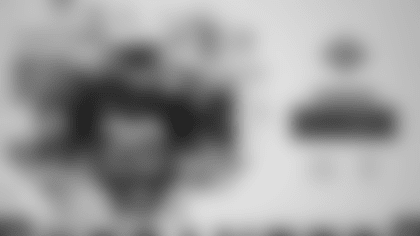Every team in the NFL does some things better than others. Some teams are particularly good at one thing, maybe even the best in the league. Think the New England Patriots and their play-action seam pass to the tight end. Or the Pittsburgh Steelers with the counter run. Or the Carolina Panthers' goal-line QB keeper.
None of these signature strengths are a secret. Opponents prepare for them in the film room and on the practice field, and yet these teams continue to succeed with the same concepts. That is, of course, often due to the presence of some especially skilled players, like Rob Gronkowski in New England, Le'Veon Bell in Pittsburgh and Cam Newton in Carolina. Still, these well-known plays generally require precise execution by many of the 11 players on the field. And when they work, they are often a thing of beauty, at least to football fans.
Each game week during Tampa Bay's 2018 regular season, we are going to look at a "Signature Play" that the Buccaneers upcoming opponent utilizes often and particularly well. With the help of images of a sample play at various points during its execution, we're going to try to understand why this play commonly works so well. This week, the opponent is the Atlanta Falcons, who can pair a former NFL MVP quarterback with perhaps the most dangerous wide receiver in the NFL, and use the threat of Julio Jones going deep to set up a nearly unstoppable route.
ATLANTA FALCONS' SIGNATURE PLAY: PLAY-ACTION PASS TO JULIO JONES ON STOP ROUTE

Atlanta's first game of 2018 was also the first game for the entire NFL, as the Falcons headed to Philadelphia for the annual Week One Thursday night showcase game against the defending Super Bowl champions. Philadelphia would win a weird, low-scoring game at the end, 18-12, but not before Jones caught 10 passes for 169 yards.
Midway through the second quarter, after the Eagles had tied the game at 3-3 with a field goal, the Falcons got the ball after a touchback at their own 25. The first play of the drive was a two-yard run by Tevin Coleman to the 27. For second down, the Falcons came out in a heavy "13" personnel with three tight ends, one back and one receiver. That lone receiver was Julio Jones (#11), who lined up wide to the left, just inside the numbers.

The Falcons line up with the strong side to the right, with all three of their tight ends outside the right tackle. However, their best pass-catching tight end, Austin Hooper (#81), then goes into motion from the right to the left. One practical result of this motion is that it reveals that Philadelphia is probably in man-to-man coverage. This is revealed when safety Malcolm Jenkins (#27), who had been up near the line of scrimmage, follows Hooper across the formation.
Otherwise, the Eagles are lined up with a single-high safety, as Rodney McLeod (#23) is playing centerfield, about 16 yards past the line of scrimmage. The Falcons are in max-protect mode with just a two-man route, as only Hooper and Jones will go out as targets for Ryan. The Eagles' defense thus has nine men in the box at the snap, and they are going to react to the first important part of this play, the play-action fake.

Tevin Coleman is the single back lined up behind Ryan, who is under center. At the snap, Ryan turns and fakes a handoff to Coleman, who is running towards left tackle. All three Philadelphia linebackers – Nathan Gerry (#47), Jordan Hicks (#58) and Kamu Grugier-Hill (#54) – immediately react to the fake by rushing forward to the line of scrimmage. Though he is not shown in this end zone shot, McLeod does not react to the fake as that is not part of his assignment as the deep single-high safety. Cornerback Ronald Darby (#21), who is matched up with Jones on the outside, playing about eight yards off as shown in the previous shot, needs to know that he has deep help over the middle from his safety.
The shot above shows how well the Falcons' max-protect scheme worked. The Eagles rush just their four down linemen, as the linebackers all back off after realizing the handoff as a fake. Grugier-Hill, in particular, reacts to the fake by keying on Coleman and staying in coverage on the running back when he leaks out of the backfield to the right.
The Falcons have their other two tight ends (Logan Paulsen, #82 and Eric Saubert, #85) double-teaming Michael Bennett (#77) on the right edge of their line. They have another double-team of the right tackle and right guard working on Fletcher Cox (#91), though the massively-talented defensive tackle does manage to shove guard Brandon Fusco (#65) aside and get around tackle Ryan Schraeder (#73) to get a free line to Ryan. He'll get there right after the ball is released, which is not in time. Center Alex Mack (#51) is ready if Hicks tries to come into the backfield, though he does not. Left guard Andy Levitre (#67) is holding up defensive tackle Haloti Ngata (#94) on his own and left tackle Jake Matthews (#70) is riding defensive end Chris Long (#56) wide around the left edge. Ryan's seven-step drop after the fake will take him away from that side and towards the two double-teamed rushers. After Coleman helps execute the play-action, he checks for a moment to see if Levitre or Matthews needs help with their me and then releases out to the left.

Hooper runs a route towards the middle of the field and then turns it into a "banana" out to the left, with Jenkins staying in man coverage, though the tight end doesn't have time to get out past the hashmarks before the ball is completed. Jones runs directly up the numbers and gets up to speed very quickly, instantly eating up the original cushion that Darby has given them.
In the shot above, Darby's uniform number is clearly visible facing the camera because the first thing he does when Jones gets near him is spin to his right, out towards the sideline. Jones has not yet made any step in either direction but Darby may be anticipating an out and he knows he has safety help over the top so he can afford to let Jones get inside on him. Just as Darby makes that spin, Jones does start to angle his route towards the middle of the field, as if he is going to run a post. Darby responds with an impressively smooth and quick spin back the other way so that he can follow Jones to the middle of the field.
It is right at that moment, about 16 yards upfield, that Jones puts on his move. The Falcons have a number of different "stop" routes they have Jones run because, as noted earlier, he is freakishly good at going from full speed to a stop. In this case, he also flattens his route out to the sideline on a dime, which is very hard to do.

Darby ends up turned in the wrong direction, facing downfield, as Jones cuts out, even though a moment earlier he had been ready to cover that exact route. Thirty yards back upfield, Ryan has begun his throwing motion at the exact moment that Jones comes to a sudden stop, and the quarterback is just releasing the ball as Jones is beginning his cut to the sideline.
Jones actually stumbles for one step after making his cut out, but he recovers quickly and has created enough space from Darby that it doesn't matter.

Again, Darby makes a quick reaction and spins out again to match Jones' route, but that bit of separation and the timing of Ryan's throw is all the Falcons need for this play to succeed at this point. Jones makes a leaping catch and lands about two yards from the sideline and Darby arrives an instant later to shove him out of bounds and keep the play from being any worse than a 22-yard gain.
McLeod, the single safety, can't be of much help all the way over on the sideline, and Jones's little fake to the post before his cut out also makes the safety pause just long enough to make sure he is not in fact going deep.
The 22-yard catch by Jones gets the ball almost to midfield and a roughing-the-passer penalty two snaps later helps get the Falcons in range for a Matt Bryant 52-yard field goal and a three-point lead. Atlanta won't come away with the win but they will be in it right to the end thanks in large part to the non-stop production of Julio Jones…especially on routes on which he does stop.


































